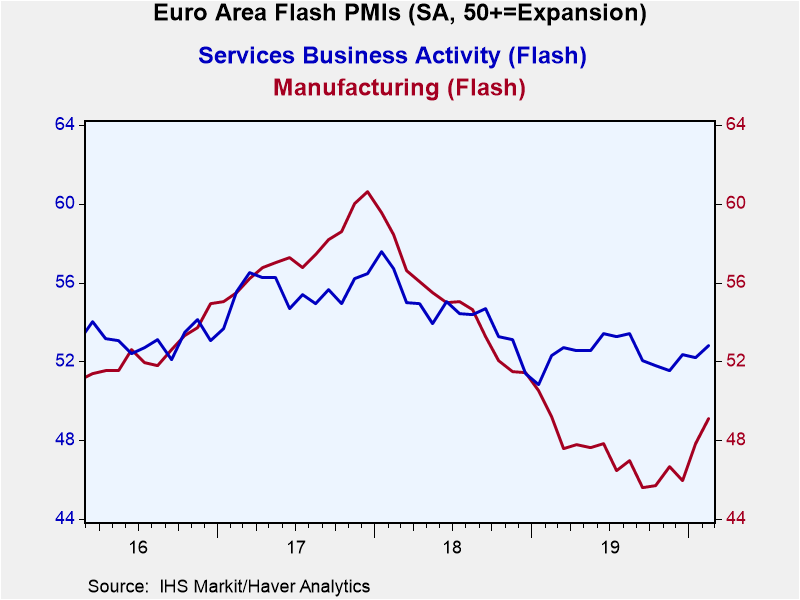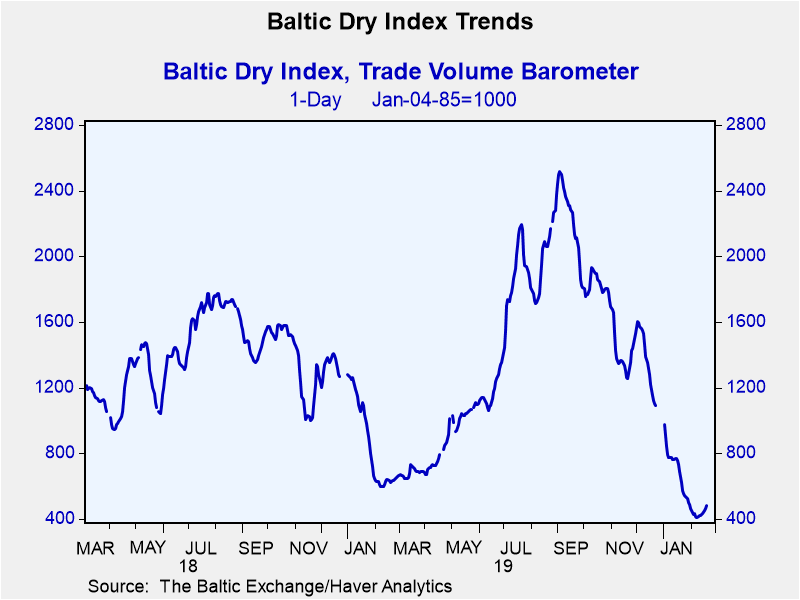 Global| Feb 21 2020
Global| Feb 21 2020PMIs Stabilize in February...Except in Japan and the U.S.
Summary
Markit flash (early release and preliminary) PMIs show (1) still-weak conditions in the EMU, (2) stabilization in the services sector, (3) an ongoing improvement in the manufacturing sector PMI even though it continues to show sector [...]
 Markit flash (early release and preliminary) PMIs show (1) still-weak conditions in the EMU, (2) stabilization in the services sector, (3) an ongoing improvement in the manufacturing sector PMI even though it continues to show sector contraction, and (4) worsening of conditions in the United States and Japan.
Markit flash (early release and preliminary) PMIs show (1) still-weak conditions in the EMU, (2) stabilization in the services sector, (3) an ongoing improvement in the manufacturing sector PMI even though it continues to show sector contraction, and (4) worsening of conditions in the United States and Japan.
Flash PMI assessments are available for five countries and for the EMU overall. The composite ranking of indicators since January 2016 shows the U.K. as the highest ranking at a standing in its 44.9 percentile followed by France's 32.7 percentile, the EMU at its 24.5 percentile, Germany at 10.2 percentile with the U.S. and Japan at their respective zero percentiles.
The table shows manufacturing contractions over three months, six months and 12 months everywhere except France and the U.S. On the Markit gauge, neither the U.S. nor France have any below-50 values for the sequential averages. However, all manufacturing gauges are below the breakeven 50 mark in February except the U.S. and the U.K. Service sector readings and sequential averages all are above the key 50 mark except for the U.S. and Japan. Japan has a below-50 reading in December and in February; the U.S. services sector has a below-50 reading in February. For the U.S., it is the first sub-50 reading for services since February 2016.
The European readings taken collectively seem to portray a smoothing of conditions in services coupled with ongoing repair to a still contracting manufacturing sector. In all cases for European countries and units, the manufacturing PMI in February is above its three-month average value adding to the notion of some rebound with stability. The services sector also displays this feature.
But for both the U.S. and Japan, the composite reading, the manufacturing reading and the service sector reading all show flash metrics below the three-month average of their respective finalized historic readings. And monthly readings for the U.S. and Japan generally erode. Except for the U.S. where manufacturing is in a straight-line weakening from December to January to February, the composite and services indexes as well as Japan's manufacturing gauge all perk up in January then deteriorate in February to a low below the December reading.
Japan has been struggling and now it has the extra problem of its proximity to China while the coronavirus is freezing parts of China's economy. The U.S. reading can only be regarded as peculiar since two regional U.S. manufacturing reports have registered some real strength in February and U.S. data, while still beset with some unevenness, have shown some strength in addition to weakness. The Markit gauge does not seem to be representative. That disconnect is compounded by the fact that while the Markit PMI for the U.S. does not contract U.S. manufacturing as measured by the index of industrial production has been declining over the past year.
 The coronavirus throws an obvious wrench into the outlook since there is no practical way to account for it. We can guess or wave our arms, we can look back at the SARS episode, but we cannot pin it down in any scientific way. We do know the direction of the effect just not the magnitude or the duration. In addition to the virus, there are ongoing trade conflicts and perhaps more such conflicts to come. Economies have been limping as the U.S. China trade rifts hit global trade as evidenced by the ongoing weakness in the Baltic index. That index mercifully has increased for the fifth day in a row, but the increases are extremely small. The chart shows that the main message from that index is how weak conditions have become...and remained. And, since that index is about freight to be delivered in the future, it suggests that we still have a good bit of weakness ahead of us.
The coronavirus throws an obvious wrench into the outlook since there is no practical way to account for it. We can guess or wave our arms, we can look back at the SARS episode, but we cannot pin it down in any scientific way. We do know the direction of the effect just not the magnitude or the duration. In addition to the virus, there are ongoing trade conflicts and perhaps more such conflicts to come. Economies have been limping as the U.S. China trade rifts hit global trade as evidenced by the ongoing weakness in the Baltic index. That index mercifully has increased for the fifth day in a row, but the increases are extremely small. The chart shows that the main message from that index is how weak conditions have become...and remained. And, since that index is about freight to be delivered in the future, it suggests that we still have a good bit of weakness ahead of us.
Robert Brusca
AuthorMore in Author Profile »Robert A. Brusca is Chief Economist of Fact and Opinion Economics, a consulting firm he founded in Manhattan. He has been an economist on Wall Street for over 25 years. He has visited central banking and large institutional clients in over 30 countries in his career as an economist. Mr. Brusca was a Divisional Research Chief at the Federal Reserve Bank of NY (Chief of the International Financial markets Division), a Fed Watcher at Irving Trust and Chief Economist at Nikko Securities International. He is widely quoted and appears in various media. Mr. Brusca holds an MA and Ph.D. in economics from Michigan State University and a BA in Economics from the University of Michigan. His research pursues his strong interests in non aligned policy economics as well as international economics. FAO Economics’ research targets investors to assist them in making better investment decisions in stocks, bonds and in a variety of international assets. The company does not manage money and has no conflicts in giving economic advice.






